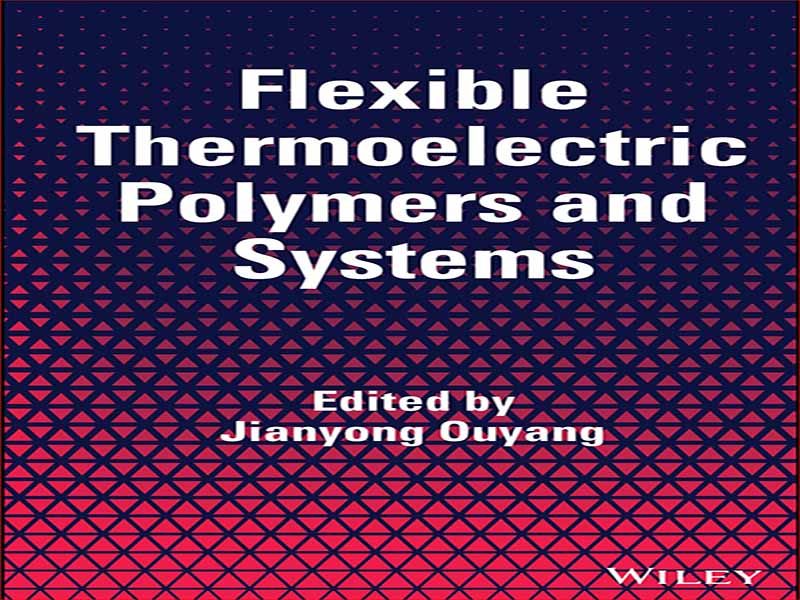- عنوان کتاب: Flexible Thermoelectric Polymers and Systems
- نویسنده: Jianyong Ouyang
- حوزه: پلیمر
- سال انتشار: 2022
- تعداد صفحه: 269
- زبان اصلی: انگلیسی
- نوع فایل: pdf
- حجم فایل: 7.83 مگابایت
مواد ترموالکتریک جالب هستند زیرا می توان از آنها برای تبدیل مستقیم گرما به برق استفاده کرد. برخی از مواد رسانا می توانند ولتاژ قابل توجهی را تحت گرادیان دما نشان دهند، یعنی اثر Seebeck. ترموولتاژ نسبت به دما را ولتاژ Seebeck می گویند. ولتاژ Seebeck بسته به تجمع حامل(های) بار در دو انتها تحت گرادیان دما می تواند مثبت یا منفی باشد. یک ماده ترموالکتریک نوع p دارای ولتاژ Seebeck مثبت است، در حالی که یک ماده ترموالکتریک نوع n دارای ولتاژ Seebeck منفی است. ضریب Seebeck بالا بر روی نیمه هادی ها و نیمه فلزات مشاهده شده است. این مقدار به موقعیت نسبی سطح فرمی از بالای نوار ظرفیت یا پایین نوار هدایت یا به سادگی سطح دوپینگ مربوط می شود زیرا تغییر در سطح دوپینگ می تواند سطح فرمی را تغییر دهد. به غیر از ضریب Seebeck، رسانایی الکتریکی بالا نیز برای تبدیل ترموالکتریک کارآمد مورد نیاز است. با این حال، یک ماده ترموالکتریک خوب باید رسانایی حرارتی پایینی داشته باشد تا بتوان از گرمای بیشتری برای تولید برق استفاده کرد. مواد ترموالکتریک به عنوان مواد فعال ژنراتورهای ترموالکتریک استفاده می شود. آنها را می توان در سیستم های خنک کننده ترموالکتریک از نظر اثر Peltier نیز استفاده کرد. مواد ترموالکتریک معمولی نیمه هادی ها یا نیمه فلزات معدنی مانند Bi2Te3 و مشتقات یا آنالوگ های آن هستند. این مواد می توانند ضریب Seebeck بالا و رسانایی الکتریکی بالایی از خود نشان دهند، اما مشکل رسانایی حرارتی بالا نیز دارند. از این رو، تلاش زیادی برای کاهش رسانایی حرارتی مواد ترموالکتریک معدنی علاوه بر بهبود ضریب Seebeck و/یا هدایت الکتریکی صورت گرفته است. برای کاربرد عملی، مواد ترموالکتریک معدنی معمولا شکننده هستند و بنابراین برای سیستم های ترموالکتریک انعطاف پذیر مناسب نیستند.
Thermoelectric materials are interesting because they can be used to directly convert heat into electricity. Some conductive materials can exhibit a notable voltage under temperature gradient, that is, the Seebeck effect. The thermovoltage with respect to the temperature is called Seebeck voltage. The Seebeck voltage can be positive or negative depending on the accumulation of the charge carrier(s) at the two ends under temperature gradient. A p-type thermoelectric material exhibits a positive Seebeck voltage, while an n-type thermoelectric material has a negative Seebeck voltage. High Seebeck coefficient has been observed on semiconductors and semimetals. The value is related to the relative position of the Fermi level from the top of the valence band or the bottom of the conduction band or simply the doping level since a change in the doping level can shift the Fermi level. Apart from the Seebeck coefficient, a high electrical conductivity is also required for efficient thermoelectric conversion. However, a good thermoelectric material should have a low thermal conductivity so that more heat can be utilized for power generation. Thermoelectric materials are used as the active materials of thermoelectric generators. They can be used in thermoelectric cooling systems in terms of the Peltier effect as well. The conventional thermoelectric materials are inorganic semiconductors or semimetals such as Bi2Te3 and its derivatives or analogues. These materials can exhibit high Seebeck coefficient and high electrical conductivity, but they also have a problem of high thermal conductivity. Hence, great effort has been made on lowering the thermal conductivity of inorganic thermoelectric materials besides on the improvement in the Seebeck coefficient and/or electrical conductivity. Consider for practical application, inorganic thermoelectric materials are usually brittle, and thus they are not suitable for flexible thermoelectric systems.
این کتاب را میتوانید از لینک زیر بصورت رایگان دانلود کنید:




































نظرات کاربران